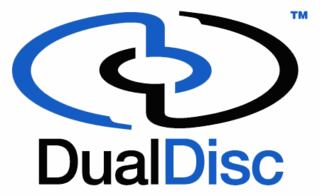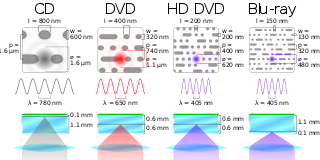
An optical disc is a flat, usually disc-shaped object that stores information in the form of physical variations on its surface that can be read with the aid of a beam of light. Optical discs can be reflective, where the light source and detector are on the same side of the disc, or transmissive, where light shines through the disc to be detected on the other side.

DVD-RAM is a DVD-based disc specification presented in 1996 by the DVD Forum, which specifies rewritable DVD-RAM media and the appropriate DVD writers. DVD-RAM media have been used in computers as well as camcorders and personal video recorders since 1998.

DVD+R DL also called DVD+R9, is a derivative of the DVD+R format created by the DVD+RW Alliance. Its use was first demonstrated in October 2003. DVD+R DL discs employ two recordable dye layers, each capable of storing nearly the 4.7 GB capacity of a single-layer disc, almost doubling the total disc capacity to 8.5 GB. Discs can be read in many DVD devices and can only be created using DVD+R DL and Super Multi drives. DL drives started appearing on the market during mid-2004, at prices comparable to those of existing single-layer drives. As of March 2011 DL media is up to twice as expensive as single-layer media. The latest DL drives write double layer discs at a slower rate than current single-layer discs.

MiniDVD is a DVD disc which is 8 centimetres (3.15 in) in diameter. The most common MiniDVDs are single layered, which can hold 1.46 GB of data, however, there also exists dual layered 2.6 GB versions, dual sided single layer 2.8 GB versions, and dual sided dual layer 5.2 GB versions. The MiniDVD is also known as a "3 inch DVD", referring to its approximate diameter in inches.

The DualDisc is a type of double-sided optical disc product developed by a group of record companies including MJJ Productions Inc., EMI Music, Universal Music Group, Sony BMG Music Entertainment, Warner Music Group, and 5.1 Entertainment Group and later under the aegis of the Recording Industry Association of America (RIAA). It featured an audio layer intended to be compatible with CD players on one side and a standard DVD layer on the other. In this respect it was similar to, but distinct from, the DVDplus developed in Europe by Dieter Dierks and covered by European patents.

Versatile Multilayer Disc was a high-capacity red-laser optical disc technology designed by New Medium Enterprises, Inc. VMD was intended to compete with the blue-laser Blu-ray Disc and HD DVD formats and had an initial capacity of up to 30GB per side. At a physical level, VMD is identical to DVD, but with the possibility of using more layers.

The Blu-ray Disc Association (BDA) is the industry consortium that develops and licenses Blu-ray Disc technology and is responsible for establishing format standards and promoting business opportunities for Blu-ray Disc. The BDA is divided into three levels of membership: the board of directors, contributors, and general members.
MultiLevel Recording was a technology originally developed by Optex Corporation and promoted by Calimetrics to increase the storage capacity of optical discs. It failed to establish itself on the market. Through a combination of proprietary media, recorder, reader and player modifications, Calimetrics proposed that ML could increase the capacity of a CD-ROM, CD-R or CD-RW to 2 GB, a single-layer DVD, DVD-R, DVD+R, DVD-RW, DVD+RW or DVD-RAM to 7.1 to 10 GB and a single-layer Blu-ray Disc (BD) to as much as 60 GB. An optionally integrated Digital Rights Management (DRM) system entitled MovieGuard was also suggested. An industry group called the ML Alliance was formed in 2000 to help commercialize ML technology. Members eventually included Calimetrics, TDK, Sanyo Semiconductor, Plextor, Matsushita Kotobuki Electronics, Mitsubishi Chemical Corporation, Verbatim, Teac and Yamaha.
DVD formats describe the physical properties of the optical disc and how data is stored and manipulated on the disc. The formats are varied according to use, with the largest differences being whether or not the disc is written to. Within each use category, there are often competing formats or implementations.

Optical storage refers to a class of data storage systems that use light to read or write data to an underlying optical media. Although a number of optical formats have been used over time, the most common examples are optical disks like the compact disc (CD) and DVD. Reading and writing methods have also varied over time, but most modern systems as of 2023 use lasers as the light source and use it both for reading and writing to the discs. Britannica notes that it "uses low-power laser beams to record and retrieve digital (binary) data."

DVD-R DL, also called DVD-R9, is a derivative of the DVD-R format standard. DVD-R DL discs hold 8.5 GB by utilizing two recordable dye layers, each capable of storing a little less than the 4.7 gigabyte (GB) of a single layer disc, almost doubling the total disc capacity. Discs can be read in many DVD devices and can only be written using DVD-R DL compatible recorders. It is part of optical disc recording technologies for digital recording to optical disc.

DVD recordable and DVD rewritable are optical disc recording technologies. Both terms describe DVD optical discs that can be written to by a DVD recorder, whereas only 'rewritable' discs are able to erase and rewrite data. Data is written ('burned') to the disc by a laser, rather than the data being 'pressed' onto the disc during manufacture, like a DVD-ROM. Pressing is used in mass production, primarily for the distribution of home video.

Forward Versatile Disc (FVD) is an offshoot of DVD developed in Taiwan jointly by the Advanced Optical Storage Research Alliance (AOSRA) and the Industrial Technology Research Institute (ITRI) as a less expensive alternative for high-definition content. The disc is similar in structure to a DVD, in that pit length is the same and a red laser is used to read it, but the track width has been shortened slightly to allow the disc to have 5.4 GB of storage per layer as opposed to 4.7 GB for a standard DVD. The specification allows up to three layers for total of 15 GB in storage. WMV9 is used as the video codec allowing for 135 minutes of 720p video on a dual layer disc, and 135 minutes of 1080i video on a three-layer disc. FVD uses AACS copy protection which is one of the schemes used in both HD DVD and Blu-ray Discs.
AVCHD is a file-based format for the digital recording and playback of high-definition video. It is H.264 and Dolby AC-3 packaged into the MPEG transport stream, with a set of constraints designed around the camcorders.

Blu-ray Disc Recordable (BD-R) and Blu-ray Disc Recordable Erasable (BD-RE) refer to two direct to disc optical disc recording technologies that can be recorded on to a Blu-ray-based optical disc with an optical disc recorder. BD-R discs can be written to once, whereas BD-RE discs can be erased and re-recorded multiple times, similar to CD-R and CD-RW for a compact disc (CD). Disc capacities are 25 GB for single-layer discs, 50 GB for double-layer discs, 100 GB ("XL") for triple-layer, and 128 GB for quadruple-layer.

This article compares the technical specifications of multiple high-definition formats, including HD DVD and Blu-ray Disc; two mutually incompatible, high-definition optical disc formats that, beginning in 2006, attempted to improve upon and eventually replace the DVD standard. The two formats remained in a format war until February 19, 2008, when Toshiba, HD DVD's creator, announced plans to cease development, manufacturing and marketing of HD DVD players and recorders.

The DVD is a digital optical disc data storage format. It was invented and developed in 1995 and first released on November 1, 1996, in Japan. The medium can store any kind of digital data and has been widely used for video programs or formerly for storing software and other computer files as well. DVDs offer significantly higher storage capacity than compact discs (CD) while having the same dimensions. A standard single-layer DVD can store up to 4.7 GB of data, a dual-layer DVD up to 8.5 GB. Variants can store up to a maximum of 17.08 GB.

Blu-ray is a digital optical disc data storage format designed to supersede the DVD format. It was invented and developed in 2005 and released worldwide on June 20, 2006, capable of storing several hours of high-definition video. The main application of Blu-ray is as a medium for video material such as feature films and for the physical distribution of video games for the PlayStation 3, PlayStation 4, PlayStation 5, Xbox One, and Xbox Series X. The name refers to the blue laser used to read the disc, which allows information to be stored at a greater density than is possible with the longer-wavelength red laser used for DVDs.

HD DVD is an obsolete high-density optical disc format for storing data and playback of high-definition video. Supported principally by Toshiba, HD DVD was envisioned to be the successor to the standard DVD format, but lost to Blu-ray, supported by Sony and others.

M-DISC is a write-once optical disc technology introduced in 2009 by Millenniata, Inc. and available as DVD and Blu-ray discs.










